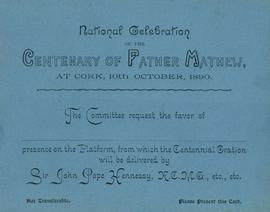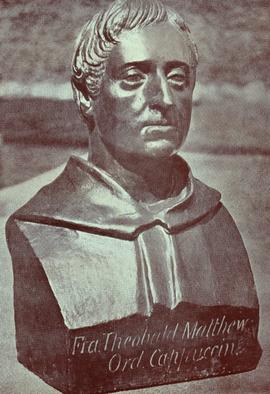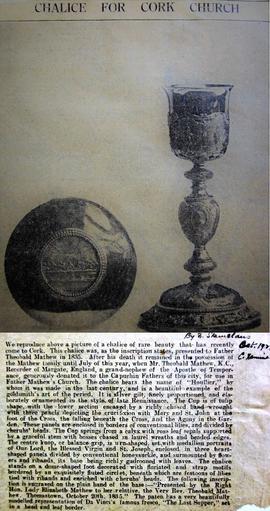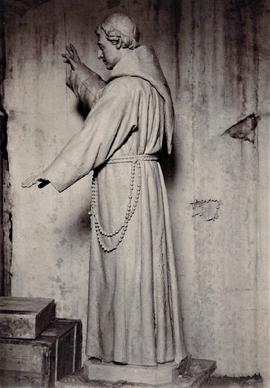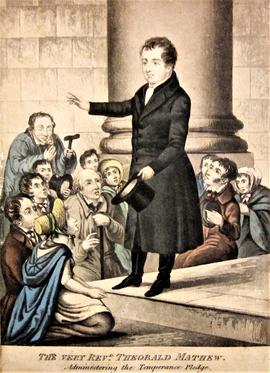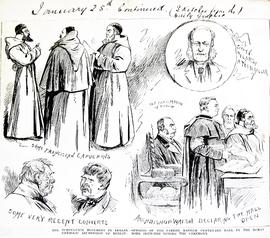Identity area
Reference code
Title
Date(s)
- 1790-2007 (Creation)
Level of description
Extent and medium
21 boxes, comprising 121 files and 626 items and approximately 6,453 pp
Context area
Name of creator
Repository
Archival history
Immediate source of acquisition or transfer
Content and structure area
Scope and content
Fr. Theobald Mathew OSFC (1790-1856)
Theobald Mathew was born at Thomastown Castle near the village of Golden in County Tipperary on 10 October 1790. The Mathews were an old landed family with both Catholic and Protestant branches. Francis Mathew (1738-1806) was the owner of Thomastown Castle. He was created Viscount Landaff in 1793, and then Earl Landaff in 1797 (the title derived from the place in Wales from which the family had come to Ireland in the seventeenth century. The title was sometimes referred to as the Earldom of Llandaff since that is the more common Welsh spelling but it is Earl Landaff in the Peerage of Ireland. The Mathews of Thomastown held this title from 1797 to 1833). In the 1760s, Francis Mathew had adopted his orphaned cousin, James Mathew, Theobald’s father. On reaching adulthood, James was appointed the agent for the Mathew estate. Unlike many of the Mathews, James remained a Catholic throughout his life. His wife, Anne Whyte, was also a Catholic. They had twelve children, the fourth of whom was Theobald. The young Theobald Mathew had a privileged childhood, enjoying favoured treatment from his Protestant relation, Lady Elizabeth Mathew, the daughter of Francis Mathew. Lady Elizabeth knew and approved of Theobald’s priestly ambitions, and in 1800 she provided the money to pay for his education at St. Canice’s, a Catholic boarding school in Kilkenny. In September 1807, Theobald enrolled at St. Patrick’s College, Maynooth, for seminary training. However, his plans were upset when in his first year he was forced to leave Maynooth in order to avoid being expelled for holding what appears to have been a drunken party for his fellow students. He was subsequently accepted by the Capuchin Franciscan Order as a novice and he made his way to Church Street in Dublin to be trained. The Capuchins, in common with many of the religious orders in Ireland, were weak at this time and were thus extremely anxious for new recruits.
On 3 April 1813 Mathew was ordained a deacon. A year later he was ordained a priest by the Most Rev. Daniel Murray (1768-1852), later Archbishop of Dublin. After a brief sojourn in Kilkenny, Fr. Mathew moved back to Cork where he came under the influence of Fr. Daniel Donovan OSFC (d. 14 Jan. 1821) who was elected Provincial Minister of the Irish Capuchins in 1816. Fr. Mathew devoted a good deal of his time to practical charitable enterprises, establishing schools for poor and orphaned children. In these schools the children were taught household skills in addition to elementary subjects. In 1821, Fr. Donovan died and Fr. Mathew was elected his successor as Provincial Minister. He would continue to hold this position until 1851. In 1832, he broke ground for an elaborate, Gothic-style Capuchin church in Cork (subsequently called The Church of the Most Holy Trinity), on Charlotte Quay (later renamed Father Mathew Quay). Due to a lack of funds the church would remain unfinished in Fr. Mathew’s lifetime. It was not until 1890 that the spire and façade were added. Nevertheless, Fr. Mathew gained an excellent reputation in the local community for his tireless endeavours in support of the poor of Cork. He was also noted for his exceptional spirit of ecumenism. He was on friendly terms with a number of leading Protestants and Quakers in the city. Fr. Mathew joined the total abstinence movement in Cork in April 1838. The Cork Total Abstinence Society was established with the avowed aim of encouraging people to make one enduring act of will which would keep them sober for life. This act of will was enshrined in the pledge to abstain from the taking of intoxicating liquor.
From the very beginning Fr. Mathew’s endeavours in the cause of temperance gained striking success. Under his leadership, teetotalism drew a large number of adherents in Cork and spread throughout Munster and eventually throughout Ireland. The Society’s ranks quickly grew, and within three months, Fr. Mathew had enrolled 25,000 new members in Cork alone. In five months, the number had increased to 130,000. He travelled across Ireland, convincing thousands more to pledge teetotalism. In August 1842, he began traveling internationally, first to Scotland, then England. At its height, just before the outbreak of the famine in 1845, Fr. Mathew’s temperance movement had enrolled three million people, or more than half of the adult population of Ireland. By the mid-1840s he was frequently travelling to Britain with equally dramatic results. The leading nationalist politician, Daniel O’Connell (1775-1847), described the temperance movement as Fr. Mathew’s ‘mighty moral crusade’. In 1847, the priests of the diocese of Cork selected him to be their bishop. However, there was strong opposition from members of the hierarchy. It was held against him that the he had accepted a pension from the Government. One long-standing critic among the bishops described him as ‘the hired tool of a heretical government’. This reflected the long-standing determination of the Catholic Church in Ireland not to accept state funding and the interference that would come in its train. Fr. Mathew’s financial mismanagement (he was known to be bountiful and generous to the point of extravagance), liberal Catholicism and Protestant associations also told against him. The Pope acceded to the almost unanimous advice of the Irish hierarchy that Fr. Mathew should not be appointed to the bishopric. Nevertheless, his standing as a popular figure remained undiminished. In July 1849, he visited the United States where he was greeted with enthusiastic acclaim. In Washington, the Congress unanimously admitted to him to a seat on the floor of the House; he was the first non-American after the Marquis de Lafayette to be so honoured. Rallies and demonstrations were held across the country to honour Ireland’s renowned ‘Apostle of Temperance’.
Despite this personal adulation, it was clear that Fr. Mathew’s movement had reached its zenith. From the late 1840s the movement began to decline almost dramatically as it had risen. His health started to fail (he had suffered a stroke in 1848) and crippling debts began to accumulate, making it increasingly difficult to continue the temperance crusade. The onset of the famine, brought about by the failure of the potato crop in 1845, dealt a grievous blow to the movement; thousands of Fr. Mathew’s followers died or emigrated in those years. Many of those who remained in Ireland had to contend with more pressing concerns than the maintenance of their pledge to abstain from alcohol. In late 1853, despite declining health, Fr. Mathew ventured to Limerick where he administered the pledge in what was his last appearance at a public meeting. In October 1854, on medical advice, he travelled to Madeira but his health continued to deteriorate. In the absence of its charismatic leader the temperance movement continued to weaken. He suffered a severe stroke in late 1856 and died in Queenstown (later Cobh), County Cork, on 8 December 1856. He was 66 years old. He was buried in St. Joseph’s Cemetery in Cork, which he had established twenty-six years earlier.
Collection Content
The surviving original correspondence of Fr. Theobald Mathew OSFC held in the Irish Capuchin Archives has been catalogued and is listed elsewhere (IE CA FM-COR). The majority of the collection listed here is comprised of research material relating to Fr. Mathew’s life and temperance crusade. In the late nineteenth century, Ireland experienced temperance revivals which had the effect of renewing popular interest in the total abstinence campaign led by Fr. Mathew in the 1840s and 1850s. Widespread public interest in his legacy remained undiminished, and his life continued to be the subject of popular admiration. The collection includes published historical works, biographical research and other copy source material relating to the ‘Apostle of Temperance’. The collection comprises compilations of archival sources and research notes compiled by Fr. Stanislaus Kavanagh OFM Cap. (1876-1965), Fr. Angelus Healy OFM Cap. (1875-1953), and Fr. Nessan Shaw OFM Cap. (1915-1997), Capuchin friars who undertook extensive research into Fr. Mathew’s life and ministry.
The fonds also contains correspondence, publications, posters, circulars, newspaper cuttings and ephemera relating to various commemorations of Fr. Mathew from the nineteenth century onward. In 1864, John Francis Maguire MP (1815-1872), Fr. Mathew’s friend and first biographer, organised the erection of a statue of him on St. Patrick’s Street in Cork sculpted by John Henry Foley (1818-1874). As part of an exhibition held in Philadelphia in 1876 to mark the centenary of American Independence, the Catholic Total Abstinence Union of America erected a statue of Fr. Mathew in Fairmont Park. His statue stood alongside three Irish-American Catholics who had played a significant role in the American Revolution, Bishop John Carroll SJ, Charles Carroll and John Barry. In 1890, to mark the centenary of Fr. Mathew’s birth, a committee with a large Protestant membership came together to erect a statue in Dublin. There were generous donations from both England and Ireland and from Irish emigrant communities in North America. The statue, by the Irish-born artist Mary Redmond (1863-1930), was unveiled on Sackville (later O’Connell) Street in February 1893. The statue depicted Fr. Mathew in a Capuchin habit, an attire he never wore in life. In 1938, as part of the celebrations of the centenary of the foundation of the Cork Total Abstinence Society, the Most Rev. David Mathew (1902-1975), the Auxiliary Bishop of Westminster, who was a great-grandnephew of Fr. Mathew, had a statute erected near his birthplace of Thomastown Castle. Similar nationwide commemorative events were held in 1956 to mark the centenary of Mathew's death. More low-key commemorations were held in 1988 (150th anniversary of the inauguration of the temperance campaign), 1990 (bi-centenary of Fr. Mathew’s death), and in 2006 (150th anniversary of his death). The collection includes correspondence, newspaper cuttings, publicity material, photographs and memorabilia concerning the organisation and celebration of these commemorative occasions.
The total abstinence movement in the Catholic Church in England was revived by Cardinal Henry Manning (1804-1892) who in 1872 founded the League of the Cross. In the same year the Catholic Total Abstinence Union of America was established. In 1887, one of its leaders, Bishop John Ireland of Saint Paul, Minnesota (1838-1918), who, as a young man in his native Kilkenny had taken the pledge from Fr. Mathew, obtained approval from Pope Leo XIII for the organisation of a total abstinence movement. In Ireland, some Capuchin friars sought to renew the campaign against intemperance. In 1880, Fr. Albert Mitchell OSFC (1831-1893) established a sodality in Dublin under the title of the ‘Temperance Society of the Sacred Thirst of Our Lord Jesus Christ’. A meeting place for the sodality was secured with the opening of Father Mathew Centennial Memorial Hall on Church Street in January 1891. A hall for a similar temperance sodality and religious confraternity was opened by the Capuchins in Cork in 1907. Temperance activity received a major boost in 1905 when the Irish hierarchy invited the Capuchins to preach a National Crusade. The crusade initially garnered widespread public enthusiasm and by 1912 the Capuchins had administered over a million pledges throughout the country.
By this point the Capuchins were not alone in tackling the scourge of intemperance in Ireland. Fr. James Cullen SJ (1841-1921) founded the Pioneer Total Abstinence Association (PTAA) in Dublin in December 1898. Although the PTAA looked to Fr. Mathew’s earlier temperance campaign for inspiration, Fr. Cullen’s movement displayed some marked differences. In his speeches, Fr. Cullen asserted that temperance among the Irish would pave the way for independence from Britain. The PTAA was not primarily directed at excessive drinkers but at devout Catholics, who were to make what was described as a heroic sacrifice to atone for the sins of intemperance. This movement was essentially devotional and firmly rooted within the Catholic Church. An essential component of the Association was devotion to the Sacred Heart with a focus on the spiritual element in the work of the PTAA. Many of the twentieth-century commemorations of Fr. Mathew were organised by the PTAA as part of the promotion of their cause. Fr. Cullen’s pioneers remained a vital force in Ireland until the 1980s, when they found themselves unable to adapt to the dramatic political, cultural, and religious changes taking hold in an increasingly secular Ireland. The collection comprises much material relating to the promotion of temperance issues by organisations such as the PTAA including newsletters, publications, publicity and commemorative material (much of which focused on Fr. Mathew’s legacy), and memorabilia. Finally, the subfonds includes a highly significant collection of artefacts such as original temperance society medals, pledge cards, prints, posters, photographs, temperance memorabilia, manuals, church plate, ephemera and other items and relics associated with Fr. Mathew and his temperance movement from the 1830s to the 1850s. These items were collected by various Capuchin friars in the late nineteenth and early twentieth centuries with a view to exhibiting them for devotional and historical purposes.
Appraisal, destruction and scheduling
Accruals
System of arrangement
The material has been catalogued (2018) and a new arrangement has been imposed upon the collection. The collection has been divided into nine series, which have been further divided into sub-series. The papers in each series represent a distinct grouping. The first series includes transcribed copies of contemporary letters and documents relating to Fr. Theobald Mathew OSFC. Some original material is extant in this series and has been listed in separate files. The second series comprises the original copy of James McKenna’s 'History of the Temperance Reformation in Ireland, England and Scotland' (1838-1846). The third series includes material associated with various commemorations and anniversaries of Fr. Mathew from the centenary of his birth (1890) to events marking the 150th anniversary of his death (2006). This series has been divided into sub-series relating to particular anniversaries connected with either Fr. Mathew or his temperance crusade. The fourth series comprises a vast collection of archival sources and research notes on Fr. Mathew compiled by later Capuchin friars and researchers. The research notes are arranged primarily under separate sections relating to the principal researcher. The fifth series contains material generated by temperance organisations and societies which post-date Fr. Mathew. The sixth series includes visual material relating to Fr. Mathew and his temperance activities. The seventh series contains a vast assemblage of newspaper clippings relating primarily to the commemoration and celebration of the ‘Apostle of Temperance’. The eight series contains a large collection of published works dealing with the life of Fr. Mathew and the progress of the Irish temperance movement. The final series lists a highly significant collection of original artefacts and memorabilia relating to Fr. Mathew and his temperance campaign from the 1830s to the 1850s.
Conditions of access and use area
Conditions governing access
Access is open to bona fide researchers. Records containing personal information are subject to access restrictions.
Conditions governing reproduction
Language of material
- English
- French
- German
- Irish
- Latin
Script of material
Language and script notes
Physical characteristics and technical requirements
The papers are generally in good condition
Finding aids
Descriptive catalogue
Allied materials area
Existence and location of originals
Existence and location of copies
Related units of description
The archives of the Pioneer Total Abstinence Association (PTAA) are held in University College Dublin Archives (UCDA). A descriptive catalogue for this collection (P145) is available at https://www.ucd.ie/t4cms/p0145-ptaa-descriptive-catalogue.pdf
Notes area
Alternative identifier(s)
Access points
Subject access points
Place access points
Name access points
Genre access points
Description control area
Description identifier
Institution identifier
Rules and/or conventions used
Status
Level of detail
Dates of creation revision deletion
Language(s)
- English

